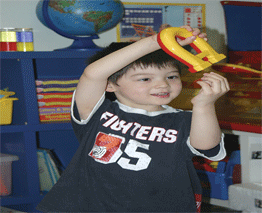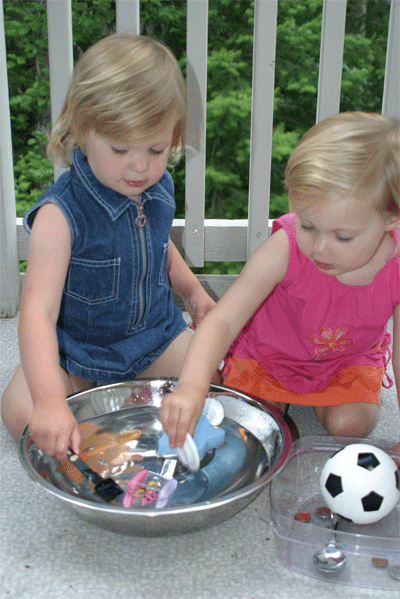This month in caregivers corner we’re going to explore some easy and fun science experiments. Children never fail to be fascinated by the cause and effect of simple science experiments. Early science helps children to learn the process of thinking by asking “how,” then “doing,” and finally “observing and concluding.” But most importantly, science is HANDS ON FUN!
Magnet Madness
Materials:
- Muffin tin
- Various object that are magnetic and non-magnetic
- Clear hard plastic
In a muffin tin, put magnetic objects and non-magnetic objects into each hole. Cut clear hard plastic that you find on toy packaging to fit over top, add clips to seal it tight so the children can’t open. Tape a magnet to the end of a string and tape onto cookie tin. Children will enjoy guessing which objects are magnetic or not, and then will take pride in informing you once they have mastered the results.
The Amazing Color Changing Flower
Materials:
- A clear jar
- Water
- Food coloring
- White carnation
- Large sheet of paper to record the children’s ideas on
Fill the clear jar with water. Show your children the carnation, food coloring, and the jar filled with water. Have your children take turns dropping food colouring into the water. Next, ask the children what do they think will happen to the white carnation if you put it in the colored water. Record the children’s responses. Place the carnation/jar in a visible place. Observe what happens to the flower for 24 hours. Talk about the changes to the flower the next day highlighting the fact that flowers “drink water” from the soil.
Sink or float!
Materials:
- Various household objects
- Bucket and water
- Paper and pen to record results
This is a quick and easy experiment in which you can explore science with children. Grab a bunch of household objects (make sure that some will sink and some will float!) Fill a bucket with water, and drop away. Ask children before they drop it if they think the item will sink or float, and record the results on a chart.
Explosion!
Materials:
- Clear film canister
- Alka Seltzer tablets
Draw a line around the bottom of a clear film canister about 1 cm from the bottom. Fill to line with warm water. Place 1/4 of an Alka Seltzer tablet in canister, immediately cover, turn the canister upside down and place on sidewalk/driveway. Stand back and wait for “explosion.” As the gases build up, the film canister bottom goes flying in the air about 20 feet. Be very careful with the tablets and flying parts. Make sure the children do not put the tablets in their mouths, they contain asprin.
Solid to Liquid
Have you ever turned a liquid into a solid just by tapping on it? In this experiment you make just such a liquid.
For this experiment you will need:
- Corn starch (about 1/4 cup, or 60 cm3)
- Water (about 1/4 cup, or 60 cm3)
- A bowl for mixing
- Newspaper
Place a sheet of newspaper flat on a table. Put the mixing bowl in the middle of the newspaper. Add 1/4 cup of dry cornstarch to the bowl. Add about 1/8 cup (2 tablespoons, or 30 cm3) of water to the corn starch and stir slowly. Add water slowly to the mixture, while stirring, until all of the powder is wet.
Continue to add water until the cornstarch acts like a liquid when you stir it slowly. When you tap on the liquid with your finger, it shouldn’t splash, but rather will become hard. If your mixture is too liquid, add more cornstarch. Your goal is to create a mixture that feels like a stiff liquid when you stir it slowly, but feels like a solid when you tap on it with your finger or a spoon.
Scoop the cornstarch mixture into the palm of your hand, then slowly work it into a ball. As long as you keep pressure on it by rubbing it between your hands, it stays solid. Stop rubbing, and it “melts” into a puddle in your palm. Can you think of other tests you can do with it?
Why does the cornstarch mixture behave like this? Here’s an answer that will keep little Newtons thinking!
We use the term “viscosity” to describe the resistance of a liquid to flow. Water, which has a low viscosity, flows easily. Honey, at room temperature, has a higher viscosity and flows more slowly than water. But if you warm honey up, its viscosity drops, and it flows more easily. Most fluids behave like water and honey, in that their viscosity depends only on temperature. We call such fluids “Newtonian,” since their behavior was first described by Isaac Newton (when he wasn’t discovering the laws of gravity or developing calculus). The cornstarch mixture you made is called “non-Newtonian” since its viscosity also depends on the force applied to the liquid, or how fast an object is moving through the liquid.
Note: Disposal - First dilute the cornstarch mixture with plenty of water before pouring it down the drain. Why? What do think would happen to the semi-solid, semi-liquid form that you prepared if pressure were applied to it by other water in the drain? Yes - a very plugged drain.
Icy Colour Changes
Materials:
- Food colouring
- Ice cube tray
- Ziploc baggies
This is a terrific visual experience of color changes. Make red, yellow and blue ice cubes using food coloring and water. Place one red and yellow in a ziplock baggie, one red and blue in a ziplock baggie, and yellow and blue, and just for fun, one of each color in one bag. As the colored ice cubes melt they create new colors. Place them in the kitchen so children can keep checking them at each meal.


